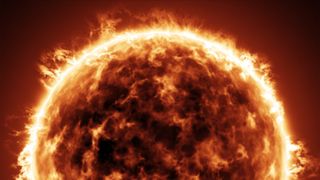Surprise solar storm bashes Earth, with a second wave predicted for Monday
The "moderate" storm is the result of sunspots.

A solar storm slammed into Earth over the weekend, and it's possible that another one could strike later on Monday (Aug. 8).
Classified as "moderate" by the National Oceanic and Atmospheric Administration (NOAA) Space Weather Prediction Center, the G2 geomagnetic storm, which pummeled our planet on Sunday (Aug. 7), was the result of a solar wind stream, or charged particles from the sun, striking Earth's magnetic field. A second storm, classified as a G1 or "minor" storm, may hit sometime today, NOAA predicted.
According to SpaceWeather.com, the weekend storm, which was not forecasted and came "unexpectedly," reached speeds of up to 373 miles per second (600 kilometers per second). Solar winds have been known to reach speeds of 500 miles per second (800 km) according to Space.com.
If another storm does hit, NOAA reported that high-latitude power systems could be impacted, which could potentially lead to issues for power grids and GPS devices. Spacecraft in orbit also could be affected, due to an increase in high-energy electrons within the magnetosphere, as well as animal behavior, as some migratory animals rely on Earth's magnetic field to navigate, Newsweek reported.
Related: Solar storm from hole in the sun will hit Earth on Wednesday (Aug. 3)
The sun is spitting out solar storms left and right these days, as it's reaching the peak of its roughly 11-year cycle, Live Science previously reported. Because of this, it's more likely that sunspots, which NASA defines as areas of the sun that appear dark due to being cooler than elsewhere on the sun's surface, will likely pop up, resulting in additional solar events. These spots appear cooler and darker than their surroundings due to strong magnetic fields inhibiting the influx of hot, new gas from the sun's interior, according to Space.com.
The ensuing solar storm sent social media ablaze, particularly in North America, where people were uploading aurora, or Northern Lights, sightings of the sky bursting into brilliant shades of purple and red.
Sign up for the Live Science daily newsletter now
Get the world’s most fascinating discoveries delivered straight to your inbox.
Tamitha Skov, a space physicist who goes by the pseudonym "Space Weather Woman," tweeted on Sunday: "We've jumped to G2-levels, mainly due to north-south-north flipping of the solar magnetic field." Every 11 years, the sun’s magnetic poles will flip, causing the south pole to become the north pole and vice versa, according to the Australian Academy of Science.
The NOAA ranks solar storms on a five-level scale, with G5 being the highest. The worst solar storm ever documented occurred in 1859 and is known as the Carrington Event. During that historic storm, the aurora borealis was seen as far south as Hawaii, and telegraph equipment sparked so wildly that offices were set on fire, according to Space.com.
Originally published on Live Science.

Jennifer Nalewicki is a Salt Lake City-based journalist whose work has been featured in The New York Times, Smithsonian Magazine, Scientific American, Popular Mechanics and more. She covers several science topics from planet Earth to paleontology and archaeology to health and culture. Prior to freelancing, Jennifer held an Editor role at Time Inc. Jennifer has a bachelor's degree in Journalism from The University of Texas at Austin.
Most Popular

